Evaluation and Prediction of Landscape Ecological Security Based on a CA-Markov Model in Overlapped Area of Crop and Coal Production
Abstract
1. Introduction
2. Materials and Methods
2.1. Study Area
2.2. Data Sources and Processing
2.3. Methods
2.3.1. Analysis of the Changing Landscape Pattern
2.3.2. Landscape Ecological Safety Evaluation Index System Construction
2.3.3. CA-Markov Models and Landscape Safety Prediction Methods
3. Results
3.1. Land Use and Landscape Pattern Change in the Study Area
3.2. Spatial and Temporal Evolution of Landscape Ecological Safety in the Study Area
3.3. Model Accuracy Validation and Landscape Pattern Evolution Prediction
3.4. Forecast of Landscape Ecological Security in the Study Area
4. Discussion
4.1. Landscape Ecological Safety Pattern
4.2. Spatial and Temporal Variation in Landscape Ecological Safety in the Study Area
4.3. Landscape Ecological Safety Predictions
5. Conclusions
- (1)
- During the study period, the landscape pattern of the study area shows obvious stage characteristics: from 2004 to 2014, the landscape pattern develops in the direction of fragmentation, irregularity, heterogeneity, and low connectivity; after 2014, it shows the trend of continuous, regular, balanced, and high connectivity changes.
- (2)
- The ecological safety of the landscape in the study area shows obvious spatial and temporal changes. In the time dimension, the overall ecological safety of the landscape in the study area from 2004 to 2019 shows a change characteristic of first becoming worse and then gradually improving. The area of the basic safety zone keeps decreasing, the area of the warning zone keeps increasing, while the area of the unsafe zone shows the characteristic of first increasing and then decreasing; on the spatial scale, the unsafe zone in 2004 is distributed mainly in the south and north of the study area. By 2019, the area of the unsafe zone in the study area was significantly reduced by the influence of land remediation and reclamation.
- (3)
- Using the 2019 land-use landscape type as the base period data, the regional landscape security status in 2029 is predicted. The study found that the degree of landscape fragmentation in the study area will tend to decrease and the landscape connectivity will increase between 2019 and 2029. The shape of landscape patches tended to be regular, and the landscape heterogeneity will be enhanced. The landscape ecological security in the study area shows a trend of improvement.
Author Contributions
Funding
Data Availability Statement
Conflicts of Interest
References
- He, T.; Xiao, W.; Zhao, Y.; Chen, W.; Deng, X.; Zhang, J. Continues Monitoring of Subsidence Water in Mining Area from the Eastern Plain in China from 1986 to 2018 Using Landsat Imagery and Google Earth Engine. J. Clean. Prod. 2021, 279, 123610. [Google Scholar] [CrossRef]
- Hu, Z. The 30 Years Land Reclamation and Ecological Restoration in China: Review, Rethinking and Prospect. Coal Sci. Technol 2019, 47, 25–35. [Google Scholar] [CrossRef]
- Chen, Z.; Yang, Y.; Zhou, L.; Hou, H.; Zhang, Y.; Liang, J.; Zhang, S. Ecological Restoration in Mining Areas in the Context of the Belt and Road Initiative: Capability and Challenges. Environ. Impact Assess. Rev. 2022, 95, 106767. [Google Scholar] [CrossRef]
- Xu, J.; Li, G.; Chen, G.; Zhao, H.; Qu, J. Changes of Landscape Ecological Quality for Land Reclamation in Mining Area. Trans. Chin. Soc. Agric. Eng. 2013, 29, 232–239. [Google Scholar]
- Bian, Z.; Lei, S.; Jin, D.; Wang, L. Several Basic Scientific Issues Related to Mined Land Remediation. J. China Coal Soc. 2018, 43, 190–197. [Google Scholar] [CrossRef]
- Gao, Y.; Huang, H.; Wu, Z. Landscape Ecological Security Assessment Based on Projection Pursuit: A Case Study of Nine Cities in the Pearl River Delta. Acta Ecol. Sin. 2010, 30, 5894–5903. [Google Scholar]
- Xiao, D.; Chen, W. On the Basic Concepts and Contents of Ecological Security. J. Appl. Ecol. 2002, 13, 354–358. [Google Scholar] [CrossRef]
- Kullenberg, G. Regional Co-Development and Security: A Comprehensive Approach. Ocean Coast. Manag. 2002, 45, 761–776. [Google Scholar] [CrossRef]
- Wang, G.; Wu, W. Regional Ecological Security Mechanism and Impact Factors Indicator System. China Saf. Sci. J. 2006, 16, 11–15. [Google Scholar] [CrossRef]
- Zuo, W.; Zhou, H.; Wang, Q. Conceptual Framework for Selection of an Indicator System for Assessment of Regional Ecological Safety. Soils 2003, 35, 2–7. [Google Scholar] [CrossRef]
- Zhang, X.C.; Ma, C.; Zhan, S.F.; Chen, W.P. Evaluation and Simulation for Ecological Risk Based on Emergy Analysis and Pressure-State-Response Model in a Coastal City, China. Procedia Environ. Sci. 2012, 13, 221–231. [Google Scholar] [CrossRef]
- Liang, P.; Liming, D.; Guijie, Y. Ecological Security Assessment of Beijing Based on PSR Model. Procedia Environ. Sci. 2010, 2, 832–841. [Google Scholar] [CrossRef]
- Du, P.; Xia, J.; Du, Q.; Luo, Y.; Tan, K. Evaluation of the Spatio-Temporal Pattern of Urban Ecological Security Using Remote Sensing and GIS. Int. J. Remote Sens. 2013, 34, 848–863. [Google Scholar] [CrossRef]
- Ma, S.-Q.; Cao, H.; Wang, J.; Lin, S. Study on Eco-Safety Early-Warning and Assessment Index System of Hainan Province. In Ecosystem Assessment and Fuzzy Systems Management; Cao, B.-Y., Ma, S.-Q., Cao, H., Eds.; Advances in Intelligent Systems and Computing; Springer International Publishing: Cham, Switzerland, 2014; Volume 254, pp. 33–43. ISBN 978-3-319-03448-5. [Google Scholar]
- Chen, Y.; Wang, J. Ecological Security Early-Warning in Central Yunnan Province, China, Based on the Gray Model. Ecol. Indic. 2020, 111, 106000. [Google Scholar] [CrossRef]
- Wang, Q.; Jin, X.; Zhou, Y. Dynamic Analysis of Coastal Region Cultivated Land Landscape Ecological Security and Its Driving Factors in Jiangsu. Acta Ecol. Sin. 2011, 31, 5903–5909. [Google Scholar]
- Yu, X.; Wu, K.; Yun, W.; Wei, H.; Liu, L.; Song, Y.; Gao, X. Analysis on Temporal and Spatial Variation of Landscape Ecological Security in Modern Agricultural Area. Trans. Chin. Soc. Agric. Eng. 2016, 32, 253–259. [Google Scholar] [CrossRef]
- XIE, Y.; GONG, J.; ZHANG, L. Dynamics of Landscape Ecological Security Based on PSR Model in Bailongjiang River Watershed. Sci. Geogra Sin. 2015, 35, 790–797. [Google Scholar] [CrossRef]
- Gao, Y.; Wu, Z.; Lou, Q.; Huang, H.; Cheng, J.; Chen, Z. Landscape Ecological Security Assessment Based on Projection Pursuit in Pearl River Delta. Environ. Monit. Assess. 2012, 184, 2307–2319. [Google Scholar] [CrossRef]
- Yu, J.; Tang, B.; Chen, Y.; Zhang, L.; Nie, Y.; Deng, W. Landscape Ecological Risk Assessment and Ecological Security Pattern Construction in Landscape Resource-Based City: A Case Study of Zhangjiajie City. Acta Ecol. Sin. 2022, 42, 1290–1299. [Google Scholar] [CrossRef]
- Li, Y.; Sun, X.; Zhu, X.; Cao, H. An Early Warning Method of Landscape Ecological Security in Rapid Urbanizing Coastal Areas and Its Application in Xiamen, China. Ecol. Model. 2010, 221, 2251–2260. [Google Scholar] [CrossRef]
- ZHANG, L.; ZHANG, S.; YE HC, H.Y. Landscape Indices of Land Damage and Land Reclamation in an Opencast Coal Mine. Resour. Sci. 2014, 36, 55. [Google Scholar]
- Gao, X.; Cai, X.; Wang, J.; Mu, Y. Analysis of Landscape Pattern Change and Its Driving Forces in Typical Mining Area of Guizhou Province during 10 Years. Environ. Sci. Technol. 2013, 36, 168–174. [Google Scholar]
- Ma, S.; Xie, F.; Ding, C.; Zhang, H. Spatio-Temporal Change of Landscape Ecological Quality and Influencing Factors Based on Four-Quadrant Model in Overlapped Area of Cropland and Coal Production. Trans. Chin. Soc. Agric. Eng. 2019, 36, 259–268. [Google Scholar] [CrossRef]
- Vivekananda, G.; Swathi, R.; Sujith, A. Multi-Temporal Image Analysis for LULC Classification and Change Detection. Eur. J. Remote Sens. 2021, 54, 189–199. [Google Scholar] [CrossRef]
- Duan, Y.; Wang, X.; Wei, Y. Land Use Change Analysis of Daishan Island Using Multi-Temporal Remote Sensing Imagery. Arab. J. Geosci. 2020, 13, 741. [Google Scholar] [CrossRef]
- Fu, G.; Wang, W.; Li, J.; Xiao, N.; Qi, Y. Prediction and Selection of Appropriate Landscape Metrics and Optimal Scale Ranges Based on Multi-Scale Interaction Analysis. Land 2021, 10, 1192. [Google Scholar] [CrossRef]
- Li, B.; Gu, H.; Ji, Y. Evaluation of Landscape Pattern Changes and Ecological Effects in Land Reclamation Project of Mining Area. Trans. Chin. Soc. Agric. Eng. 2012, 28, 251–256. [Google Scholar] [CrossRef]
- Wu, J.; Yu, X. Landscape Ecology, Patterns, Processes, Scales and Grades. Beijing High. Educ. Press 2007, 4, 106–120. [Google Scholar]
- Qing, F.T.; Peng, Y. Temporal and Spatial Characteristics of Ecological Risk in Shunyi, Beijing, China Based on Landscape Structure. Chin. J. Appl. Ecol. 2016, 27, 1585–1593. [Google Scholar] [CrossRef]
- Liu, P.; Zhang, X.; Ma, C.; Zhang, H.; Han, R.; Lu, X. Ecological Security Assessment Based on Remote Sensing and Landscape Ecology Model. J. Sens. 2021, 2021, 6684435. [Google Scholar] [CrossRef]
- Gkyer, E. Understanding Landscape Structure Using Landscape Metrics. In Advances in Landscape Architecture; Ozyavuz, M., Ed.; InTech: London, UK, 2013; ISBN 978-953-51-1167-2. [Google Scholar]
- Ji, D.Q.; Wen, Y.; Wei, J.B.; Wu, Z.F.; Cheng, J.; Liu, Q. Dynamic Trend of Land Use Landscape Ecological Security in Liuxihe Watershed. Trop. Geogr. 2013, 33, 299–306. [Google Scholar] [CrossRef]
- Xie, G.; Zhen, L.; Lu, C.-X.; Xiao, Y.; Chen, C. Expert Knowledge Based Valuation Method of Ecosystem Services in China. J. Nat. Resour 2008, 23, 911–919. [Google Scholar]
- Wang, Y.; Yu, X.; He, K.; Li, Q.; Zhang, Y.; Song, S. Dynamic Simulation of Land Use Change in Jihe Watershed Based on CA-Markov Model. Trans. Chin. Soc. Agric. Eng. 2011, 27, 330–336. [Google Scholar] [CrossRef]
- Guan, D.; Li, H.; Inohae, T.; Su, W.; Nagaie, T.; Hokao, K. Modeling Urban Land Use Change by the Integration of Cellular Automaton and Markov Model. Ecol. Model. 2011, 222, 3761–3772. [Google Scholar] [CrossRef]
- Ye, B.; Bai, Z. Simulating Land Use/Cover Changes of Nenjiang County Based on CA-Markov Model; Springer: Berlin/Heidelberg, Germany, 2007; pp. 321–329. [Google Scholar]
- Sang, L.; Zhang, C.; Yang, J.; Zhu, D.; Yun, W. Simulation of Land Use Spatial Pattern of Towns and Villages Based on CA–Markov Model. Math. Comput. Model. 2011, 54, 938–943. [Google Scholar] [CrossRef]
- Hishe, S.; Bewket, W.; Nyssen, J.; Lyimo, J. Analysing Past Land Use Land Cover Change and CA-Markov-Based Future Modelling in the Middle Suluh Valley, Northern Ethiopia. Geocarto Int. 2020, 35, 225–255. [Google Scholar] [CrossRef]
- Zhou, L.; Dang, X.; Sun, Q.; Wang, S. Multi-Scenario Simulation of Urban Land Change in Shanghai by Random Forest and CA-Markov Model. Sustain. Cities Soc. 2020, 55, 102045. [Google Scholar] [CrossRef]
- Zhang, M.; Wang, J.; Li, S.; Feng, D.; Cao, E. Dynamic Changes in Landscape Pattern in a Large-Scale Opencast Coal Mine Area from 1986 to 2015: A Complex Network Approach. Catena 2020, 194, 104738. [Google Scholar] [CrossRef]
- Peng, B.; Chen, D.; Li, W.; Wang, Y. Stability of Landscape Pattern of Land Use: A Case Study of Changde. Sci. Geogr. Sin. 2013, 33, 1484–1488. [Google Scholar]
- Zongming, W.; Bai, Z.; Shuqing, Z. Study on the Effects of Land Use Change on Ecosystem Service Values of Jilin Province. J. Nat. Resour. 2004, 19, 55–61. [Google Scholar]
- Chang, X.; Li, X.; Li, X.; Guo, P.; Gao, F. Spatial-Temporal Heterogeneity of Ecological Risk of Land Use in Mining Areas. Acta Ecol. Sin. 2019, 39, 3075–3088. [Google Scholar]
- Wu, J.; Zhu, Q.; Qiao, N.; Wang, Z.; Sha, W.; Luo, K.; Wang, H.; Feng, Z. Ecological Risk Assessment of Coal Mine Area Based on “Source-Sink” Landscape Theory—A Case Study of Pingshuo Mining Area. J. Clean. Prod. 2021, 295, 126371. [Google Scholar] [CrossRef]
- Zhang, L.; Zhou, Y.; Men, M.; Xu, H.; Wang, S. Land Use Scenario Simulation with Different Types of Ecological Security. Trans. Chin. Soc. Agric. Eng. 2015, 31, 308–316. [Google Scholar] [CrossRef]
- Feng, J.; Dong, G.; Guo, L.; Wen, Q. Ecological Responses to Changing Landscape Patterns in Yushenfu Mining Area. Arid Zone Res. 2014, 31, 1141–1146. [Google Scholar] [CrossRef]
- WANG, M.; LIU, X. Ecological Risk Assessment of Hong He County in Yunnan Province Based on Landscape Heterogeneity. J. Gansu Agric. Univ. 2016, 51, 101–107. [Google Scholar] [CrossRef]
- Xu, J.; Zhao, H.; Li, G.; Wu, L.; Fu, J. Land Ecological Assessment and Its Spatial Variation in Coal Mining Area. J. China Univ. Min. Technol. 2017, 46, 192–200. [Google Scholar]
- Yang, H.; Zhong, X.; Deng, S.; Nie, S. Impact of LUCC on Landscape Pattern in the Yangtze River Basin during 2001–2019. Ecol. Inform. 2022, 69, 101631. [Google Scholar] [CrossRef]
- Xu, J.; Zhao, H.; Yin, P.; Bu, N.; Li, G. Impact of Underground Coal Mining on RegionalLandscape Pattern Change Based on Life Cycle:A Case Study in Peixian, China. Pol. J. Environ. Stud. 2019, 28, 4455–4465. [Google Scholar] [CrossRef]
- Wang, J.; Cui, B.; Liu, J.; Yao, H.; Zhai, H. The Effect of Land Use and Its Change on Ecological Risk in the Lancang River Watershed of Yunnan Province at the Landscape Scale. Acta Sci. Circumstantiae 2008, 28, 269–277. [Google Scholar] [CrossRef]
- Jinrui, L.; Zongzhu, C.; Yiqing, C.; Xiaohua, C.; Yuanling, L.; Tingtian, W. Dynamic Analysis of Wetland Landscape Ecological Security Pattern of Hainan Island in 1990–2018. Ecol. Environ. 2020, 29, 293. [Google Scholar] [CrossRef]
- Feng, H.; Zhou, J.; Zhou, A.; Xu, H.; Su, D.; Han, X. Spatiotemporal Variation Indicators for Vegetation Landscape Stability and Processes Monitoring of Semiarid Grassland Coal Mine Areas. Land Degrad. Dev. 2022, 33, 3–17. [Google Scholar] [CrossRef]
- Zhou, S. Study on the Evaluation and Forewarning of Wetland Landscape Ecological Security for the Coal Resource-Based Cities Based on Scenario Simulation. Ph.D. Thesis, China University of Mining and Technology, Beijing, China, 2020. [Google Scholar]
- Wang, D.; Ji, X.; Li, C.; Gong, Y. Spatiotemporal Variations of Landscape Ecological Risks in a Resource-Based City under Transformation. Sustainability 2021, 13, 5297. [Google Scholar] [CrossRef]
- Li, S.; Xiao, W.; Zhao, Y.; Lv, X. Incorporating Ecological Risk Index in the Multi-Process MCRE Model to Optimize the Ecological Security Pattern in a Semi-Arid Area with Intensive Coal Mining: A Case Study in Northern China. J. Clean. Prod. 2020, 247, 119143. [Google Scholar] [CrossRef]
- Meng, X.; Ren, Z.; Dai, R. Ecological Security Evaluation and Its Forecast Analysis of Baoji City Using Pressure- State-Response Model. Bull. Soil Water Conserv. 2012, 32, 231–235. [Google Scholar] [CrossRef]
- Guan, D.; Zhao, Z.; Tan, J. Dynamic Simulation of Land Use Change Based on Logistic-CA-Markov and WLC-CA-Markov Models: A Case Study in Three Gorges Reservoir Area of Chongqing, China. Environ. Sci. Pollut Res. 2019, 26, 20669–20688. [Google Scholar] [CrossRef] [PubMed]
- Mansour, S.; Al-Belushi, M.; Al-Awadhi, T. Monitoring Land Use and Land Cover Changes in the Mountainous Cities of Oman Using GIS and CA-Markov Modelling Techniques. Land Use Policy 2020, 91, 104414. [Google Scholar] [CrossRef]
- Tao, X.; Zhu, J. Analysis of Early-Warning Evaluation of Ecological Safety and Driving Force in Mining Area Based on Scenario Prediction A Case of Yima Coal-Mining Area. Resour. Dev. Mark. 2016, 32, 298–303. [Google Scholar] [CrossRef]
- Qu, Y.; Zong, H.; Su, D.; Ping, Z.; Guan, M. Land Use Change and Its Impact on Landscape Ecological Risk in Typical Areas of the Yellow River Basin in China. Int. J. Environ. Res. Public Health 2021, 18, 11301. [Google Scholar] [CrossRef]
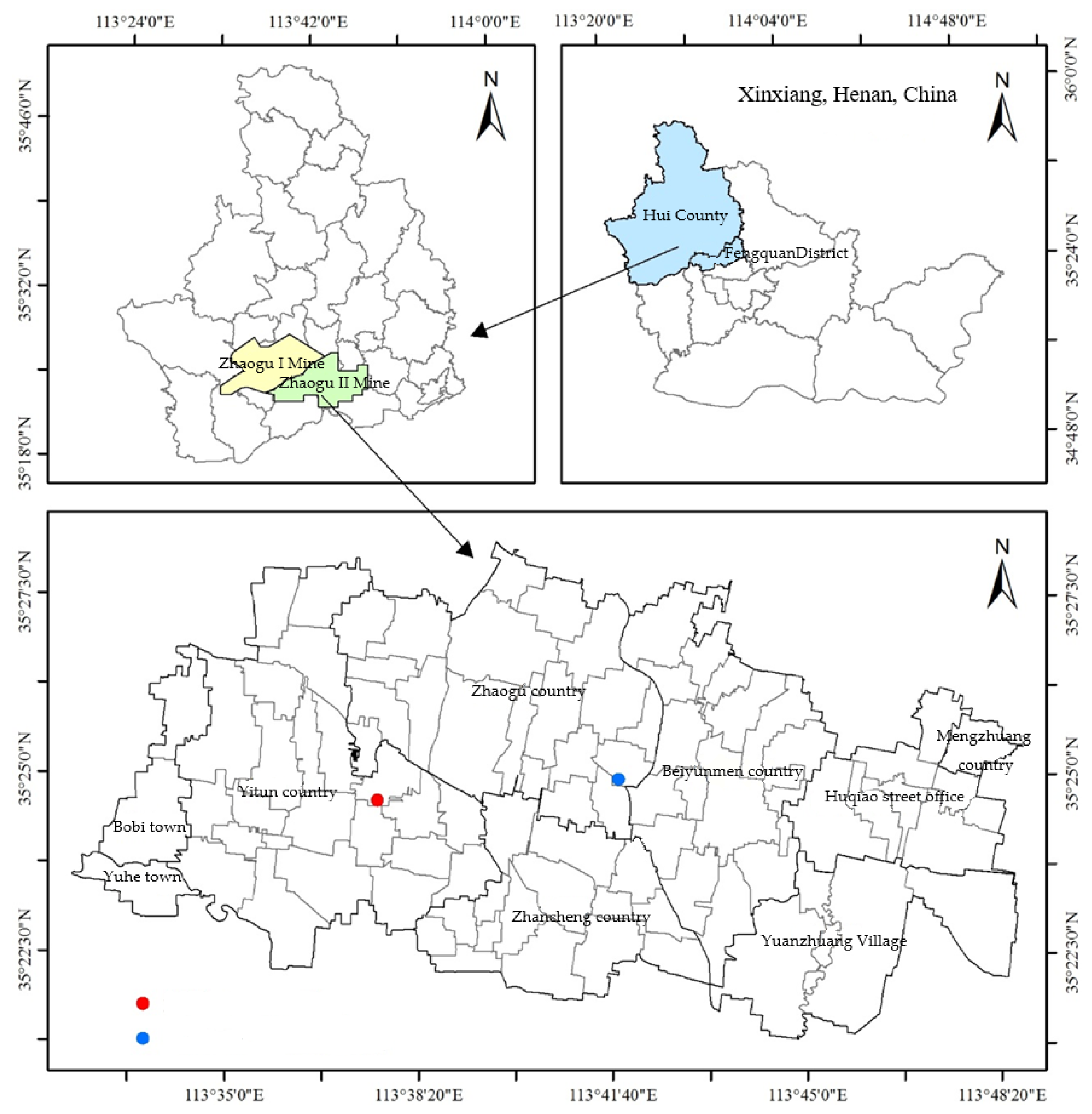
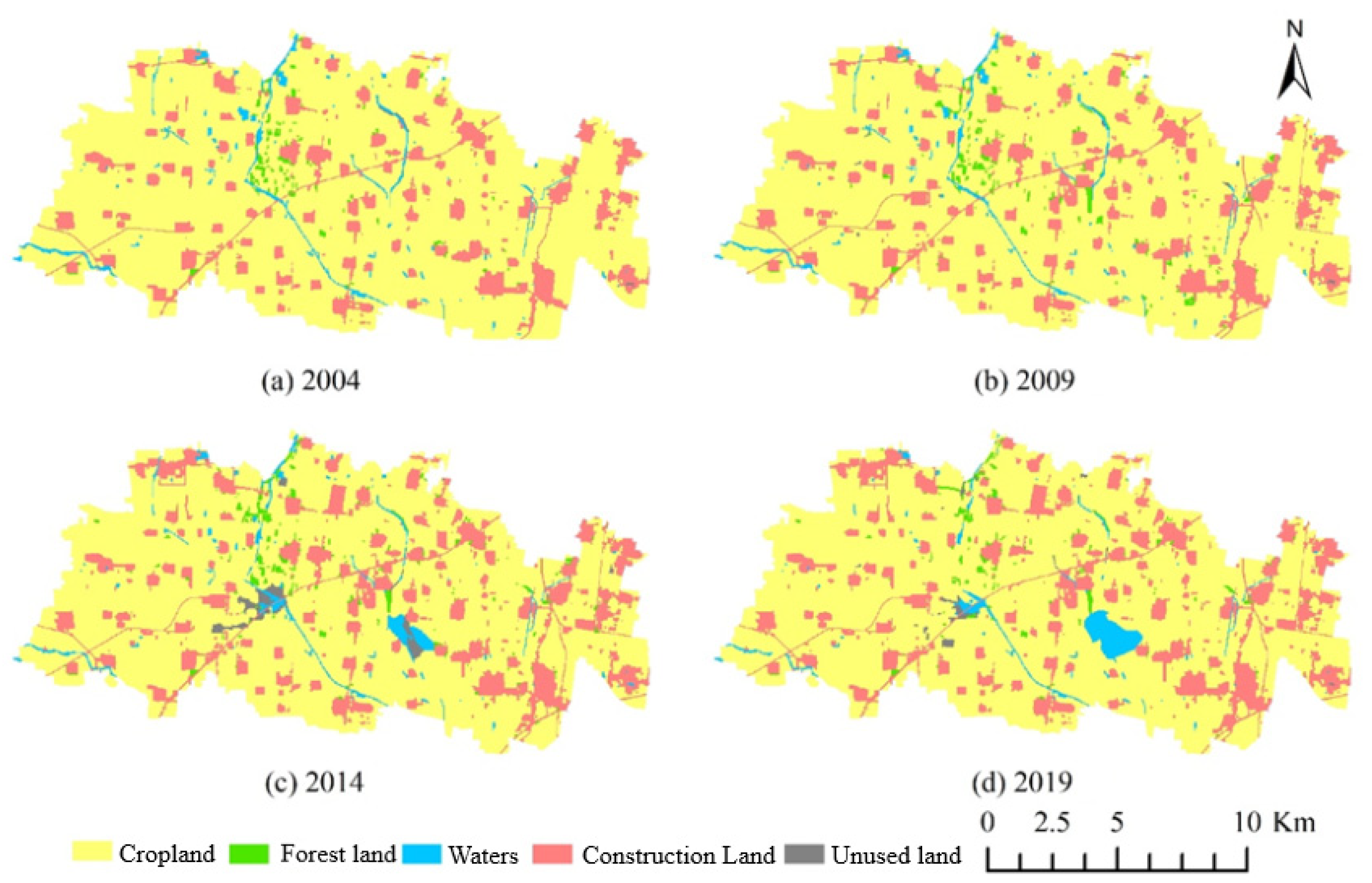

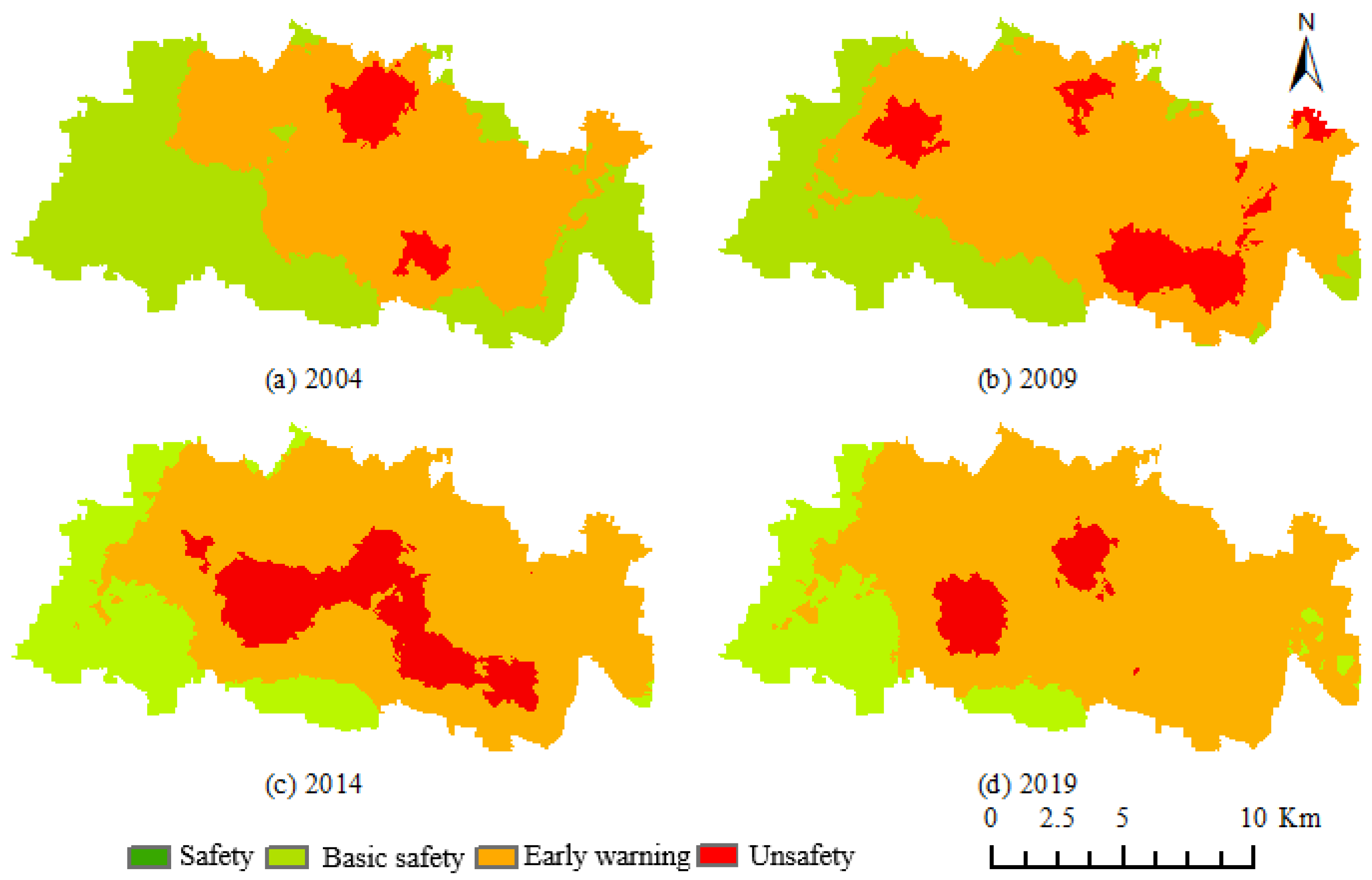

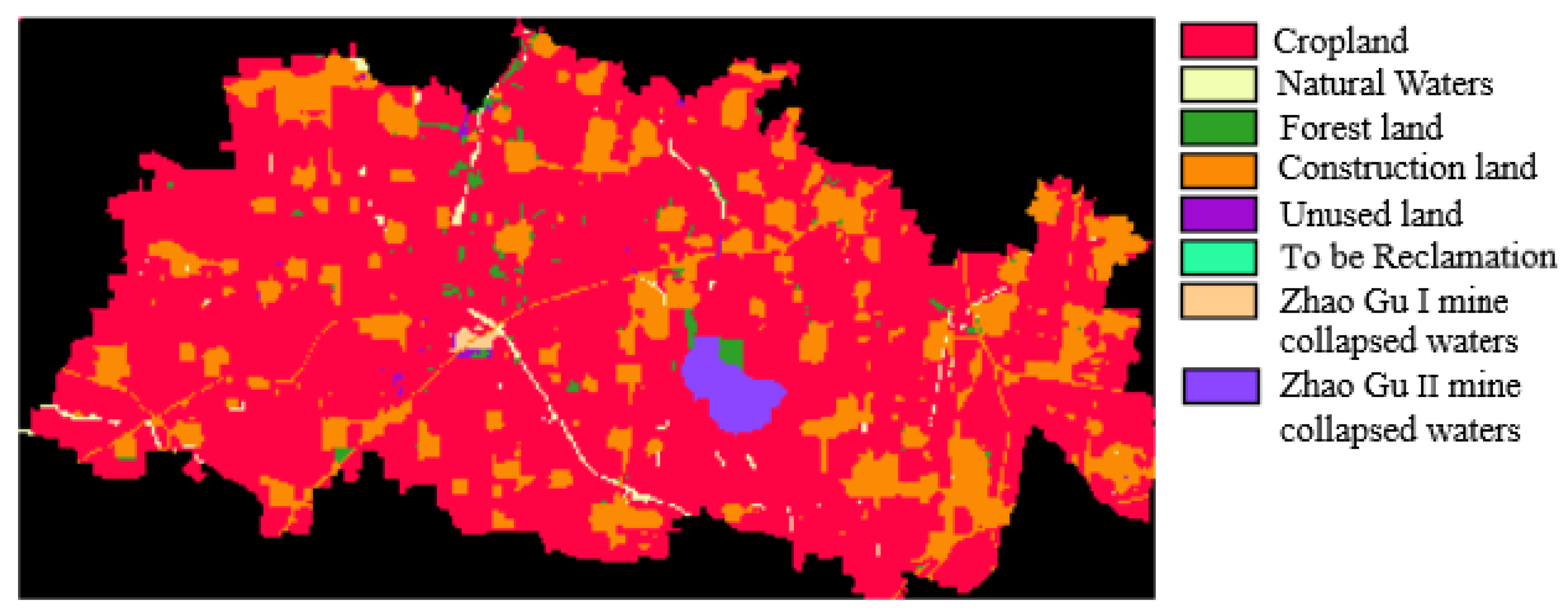
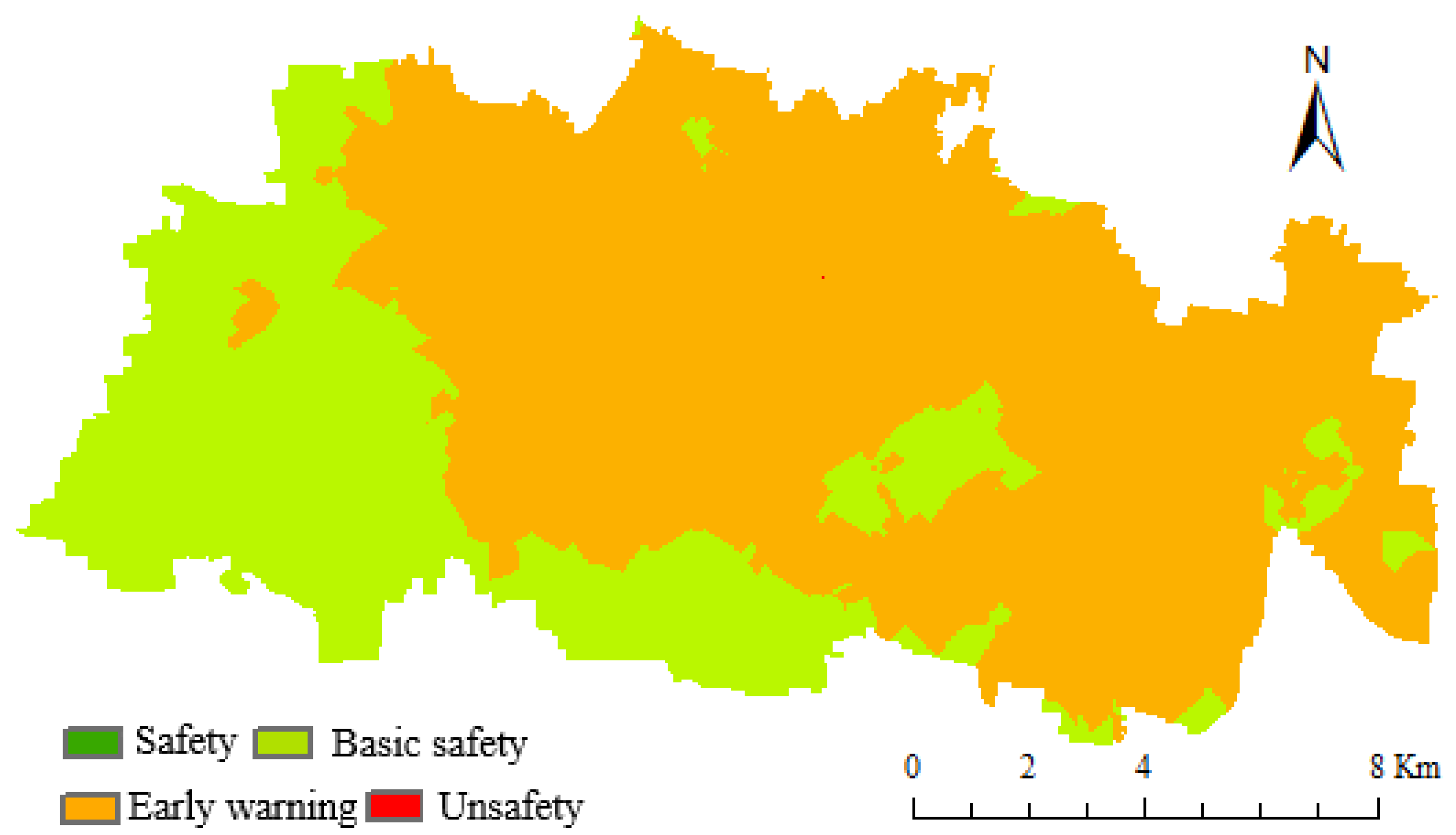
| Data Name | Time | Data sources | Usage |
|---|---|---|---|
| Landsat5 TM | 30 August 2004–12 August 2009 | USGS Web Site: https://www.usgs.gov/ (accessed on 20 July 2021) | Extraction of land use landscape type in mining area |
| Landsat8 OLI | 10 August 2014–25 September 2019 | ||
| Land Use Change Survey Data for Hui County and Fengquan District | 2015 | Xinxiang City Bureau of Land and Resources | Extraction of the extent of the study area; verification of classification accuracy |
| Zhaogu I and II mine boundaries | 2019 | Jiaozuo Coal Industry Group | |
| Village relocation data | 2005–2030 | Establishment of land use landscape type conversion rules | |
| Ecological reclamation data |
| Index | Formula | Explanation | Weight | |
|---|---|---|---|---|
| Landscape pressure | Intensity of development and use of building land (CD) | Reflects the degree to which the landscape ecosystems in the study area can withstand the pressures and stresses caused by human construction activities. | 0.36 | |
| Mining pressure (CM) | Measuring the extent to which surface subsidence caused by underground mining at a mine site has damaged its surrounding landscape. | 0.64 | ||
| Landscape structure | Landscape Structural Safety Index (LPS) | The disturbance index E and the vulnerability index F are used to construct the landscape pattern security index. E reflects the extent to which different landscape ecosystems are affected by natural or human activities, and can be obtained by superimposing weights on the landscape fragmentation index C, separation index N, and dominance index D [32]. The landscape fragility index F indicates the resistance of different landscape types to external stresses or disturbances [33]. | ||
| Ecological effect of landscape | Biological richness (BAI) | Reflects the differences in the number of organisms per unit area in areas of different landscape types. | 0.27 | |
| Vegetation cover (VCI) | Reflects the evaluation of the strengths and weaknesses of regional ecosystems and environments. | 0.25 | ||
| Landscape Ecological Service Value (ESV) | Refers to the material goods, ecological environment, and landscape culture provided directly or indirectly for human survival and development through the structure and function of ecosystems and their ecological processes. Refer to the table of ecological service value equivalents per unit area of ecosystems in China (2007 version) [34]. | 0.48 | ||
| Landscape Type | 2004 | 2009 | 2014 | 2019 | ||||
|---|---|---|---|---|---|---|---|---|
| Area (hm2) | Ratio (%) | Area (hm2) | Ratio (%) | Area (hm2) | Ratio (%) | Area (hm2) | Ratio (%) | |
| Cultivated land | 15,960.15 | 83.22 | 15,502.77 | 80.83 | 14,892.39 | 77.65 | 15,028.20 | 78.36 |
| Construction land | 2661.30 | 13.88 | 3046.14 | 15.88 | 3423.06 | 17.85 | 3428.82 | 17.88 |
| Water area | 379.08 | 1.98 | 340.56 | 1.78 | 412.11 | 2.15 | 456.21 | 2.38 |
| Forest land | 163.89 | 0.85 | 271.44 | 1.42 | 266.22 | 1.39 | 189.18 | 0.99 |
| Unutilized land | 14.04 | 0.07 | 17.55 | 0.09 | 184.68 | 0.96 | 76.05 | 0.40 |
| Landscape Ecological Security Grade | 2004 | 2004–2009 | 2009 | 2009–2014 | 2014 | 2014–2019 | 2019 | ||||
|---|---|---|---|---|---|---|---|---|---|---|---|
| Area (hm2) | Ratio (%) | Change Rate (%) | Area (hm2) | Ratio (%) | Change Rate (%) | Area (hm2) | Ratio (%) | Change Rate (%) | Area (hm2) | Ratio (%) | |
| Safety | 0.00 | 0.00 | 0.00% | 0.00 | 0.00 | 0.00% | 0.00 | 0.00 | 0.00% | 0.00 | 0.00 |
| Basic safety | 8708.40 | 45.41 | −18.60% | 5140.62 | 26.80 | −5.94% | 4001.40 | 20.86 | −1.11% | 3789.45 | 19.76 |
| Early warning | 9550.62 | 49.80 | 12.82% | 12,010.23 | 62.62 | 1.22% | 12,244.59 | 63.85 | 10.70% | 14,296.86 | 74.55 |
| Unsafe | 919.44 | 4.79 | 5.78% | 2027.61 | 10.57 | 4.72% | 2932.47 | 15.29 | −9.60% | 1092.15 | 5.69 |
| Years | AREA_MN | LSI | SHDI | CONTAG |
|---|---|---|---|---|
| 2019 | 44.1900 | 13.6337 | 0.6553 | 73.0470 |
| 2029 | 48.4307 | 12.3496 | 0.6611 | 73.4161 |
Disclaimer/Publisher’s Note: The statements, opinions and data contained in all publications are solely those of the individual author(s) and contributor(s) and not of MDPI and/or the editor(s). MDPI and/or the editor(s) disclaim responsibility for any injury to people or property resulting from any ideas, methods, instructions or products referred to in the content. |
© 2023 by the authors. Licensee MDPI, Basel, Switzerland. This article is an open access article distributed under the terms and conditions of the Creative Commons Attribution (CC BY) license (https://creativecommons.org/licenses/by/4.0/).
Share and Cite
Zhang, H.; Yan, Q.; Xie, F.; Ma, S. Evaluation and Prediction of Landscape Ecological Security Based on a CA-Markov Model in Overlapped Area of Crop and Coal Production. Land 2023, 12, 207. https://doi.org/10.3390/land12010207
Zhang H, Yan Q, Xie F, Ma S. Evaluation and Prediction of Landscape Ecological Security Based on a CA-Markov Model in Overlapped Area of Crop and Coal Production. Land. 2023; 12(1):207. https://doi.org/10.3390/land12010207
Chicago/Turabian StyleZhang, Hebing, Qingqing Yan, Fangfang Xie, and Shouchen Ma. 2023. "Evaluation and Prediction of Landscape Ecological Security Based on a CA-Markov Model in Overlapped Area of Crop and Coal Production" Land 12, no. 1: 207. https://doi.org/10.3390/land12010207
APA StyleZhang, H., Yan, Q., Xie, F., & Ma, S. (2023). Evaluation and Prediction of Landscape Ecological Security Based on a CA-Markov Model in Overlapped Area of Crop and Coal Production. Land, 12(1), 207. https://doi.org/10.3390/land12010207








